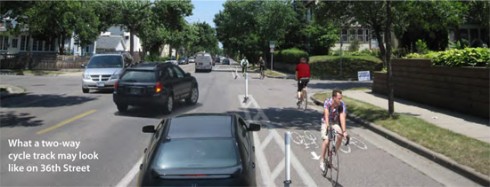The Photoshop School of Traffic Engineering strikes again, this time in Minneapolis.
For background, please read the Minneapolis blog post: http://www.ouruptown.com/2012/08/potential-cycle-track-coming-to-36th-street
Also please read John Schubert’s comment on that post.
I’ve added a comment too — still in moderation as I write this, and I repeat the comment here, slightly edited and with this introduction.
The location described in the blog post, 36th Street at Dupont Avenue, is shown in the Google map below. If the full image doesn’t appear, clicking to refresh the page will probably fix that. The image is zoomable and draggable, but by clicking on “View Larger Map”, you may enlarge it, look down from different overhead angles, and switch in and out of Google Street View.
36th Street is part of a grid system. Smaller, lightly-traveled 35th Street is one of several that could instead be configured as a bicycle boulevard (also called neighborhood greenway) like those in Berkeley, Eugene, Portland and Seattle, so bicyclists use the street as a through route while only slow, local motor traffic uses it. That is popular with residents and avoids the problems with sight lines which John Schubert has described.
Now for some comments on the pictures in the Minneapolis blog post. They are examples of of what I call the “Photoshop School of Traffic Engineering”, Or the “Anything Goes” school. Well, anything goes in a Photoshopped picture but not necessarily in reality.
Here’s the first picture from the blog post:
The caption for this photo in the blog post reads “[a] possible cycle track is being considered for 36th Street in Minneapolis.” As we’ll see though, the rendering in the picture is hardly possible.
In the picture, there’s already a sidewalk on both sides but now also a special lane so pedestrians can walk in the street. To make room for this and the bikeway, the blue car in the right-hand travel lane is squished to about 3 feet wide and that lane is about 8 feet wide. The text describes the bikeway as 10 feet wide, but it measures as about 12 feet wide based on the size of the bicycle wheels. 36th Street has a cross street every 300 feet, also entrances to back alleys and driveways in almost every block, but the picture shows maybe one intersection (note crosswalk lines) in the distant background. That is unreal. There’s some need for people to get in and out of all those cross streets, alleys and driveways.
Now, the other picture:
The caption in the blog post reads “[a] rendering of how a cycle track on 36th Street could look east of Dupont Avenue in Minneapolis.” Again, no, it couldn’t.
The bikeway is shown at a more realistic width. I’m not sure though how three travel lanes, a parking lane, 3-foot buffer and 10-foot-wide bikeway fit into a street which now has only two travel lanes and two parking lanes. Also note the car about to turn right across a lane of traffic and then across the bikeway at the one intersection shown. The lane with the closest car in it is shown as a lane of traffic, not a parking lane, or there would be signs and markings to indicate that. Assuming though that it is a parking lane and the turning car isn’t cutting off the closer one, then the closer one is still hiding approaching bicyclists from the turning one, whose driver must look to the right rear to see them as they get closer — remember, they may be traveling at speeds up to 25 miles per hour. The bikeway is outside the field of view of the turning driver’s right-hand rear view mirror. Some vehicles have no windows behind the front seat, and so the bikeway would be in a complete blind spot. I just got back from Montreal where I rode bikeways like this and it’s hair-raising with heavy two-way bicycle traffic in such a narrow space. I also had repeated conflicts with motorists turning across my path, using intimidation to try to make a gap for themselves in the stream of bicyclists. It’s safer to ride on 36th street just as it is now, and a bicycle boulevard would be better choice yet, especially for slower and more timid bicyclists. As John Schubert says in his comment on the blog post, there are better ways to make bicycling inviting.
The proposed design isn’t about improving traffic conditions, for bicyclists or anyone else. It’s about a social agenda: creating the appearance of safety for naive bicyclists to increase bicycle mode share, and making motoring more difficult. Actually, motorists would instead use the smaller parallel streets. Elimination of parking on one side of the street to create the bikeway is unlikely to be popular with residents. Snow clearance also is difficult with barrier posts and parked cars in the middle of the street.
The Montreal bikeways are the subject of a widely-publicized research study claiming a safety advantage, but the study has been demolished, see http://john-s-allen.com/reports/montreal-kary.htm



Thanks for the heads up, John, and for the reference by you and Schubert to Montreal. Deja vu all over again, eh?